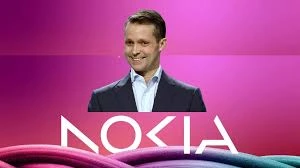FINLAND (TECHY QUANTUM) — Nokia CEO Justin Hotard compared the rapid rise of artificial intelligence to the internet boom of the 1990s while stressing that the company’s Nokia AI strategy is focused on long term growth rather than short term speculation.
Speaking in an interview with Reuters, Hotard downplayed concerns about a potential bubble in AI investments. “Even if there is a bubble or temporary downturn, the underlying trends in AI are very favorable,” Hotard said.
His remarks come as financial markets debate whether the surge in AI spending is sustainable. A Bank of America survey indicated that more than half of fund managers believe AI stocks are overvalued.
Industry leaders, including Amazon founder Jeff Bezos and OpenAI CEO Sam Altman, have also warned that investor enthusiasm could lead to substantial losses.
Nokia, traditionally known for mobile network equipment, has increasingly pivoted toward AI and cloud infrastructure to meet growing demand for data centers.
The company strengthened its capabilities with the $2.3 billion acquisition of US based optical networking firm Infinera, a major supplier for intra data center communications.
European regulators approved the acquisition earlier this year, noting no competition concerns. Hotard, who joined Nokia from Intel in April 2025, previously led Intel’s data centers and AI divisions.
Under his guidance, Nokia established a dedicated Technology and AI organization led by Chief Technology Officer Pallavi Mahajan, a former Intel executive.
The initiative is central to Nokia’s long term AI strategy, integrating AI across radio access, fiber networks, and data center solutions. Industry analysts have mixed opinions on the current AI market.
Dr. Emily Tran, a technology strategist at GlobalTech Research, said, “Nokia’s AI strategy shows strong long term planning, but investors should differentiate between market hype and sustainable growth.”
Mark Reynolds, a portfolio manager at Horizon Capital, warned, “Valuations in the AI sector are rising rapidly, and a market correction could occur. Companies with solid fundamentals like Nokia may withstand it, but speculative players face risk.”
Despite these concerns, the demand for AI capable infrastructure is growing sharply. Hotard emphasized that Nokia is experiencing growth “across the board,” from large technology firms to smaller European companies expanding their data center capacity.
He added that incremental investment in AI infrastructure is driving significant increases in volume. Nokia’s third quarter 2025 report reinforced investor confidence.
Net sales rose 12 percent to €4.83 billion, while operating profit reached €435 million, exceeding analysts’ estimates of €342 million. Growth was largely driven by demand for optical networking and cloud services supporting AI driven data centers.
Following the earnings release, Nokia shares rose more than 10 percent, adding roughly €3 billion to the company’s market capitalization.
AI and cloud related sales accounted for six percent of net revenue and 14 percent of total network infrastructure revenue, highlighting the importance of the company’s Nokia AI strategy in driving business growth.
Experts see Nokia’s AI expansion as a strategic move. “The company is clearly positioning AI at the center of its growth plan,” said Dr. Rajesh Mehta, an independent telecom consultant in London.
“Investments in optical networking and data centers are essential to support next generation AI applications.” Helsinki based analyst Sari Laaksonen added, “Integrating AI into core network infrastructure shows a vision beyond short term profits.
Nokia’s AI strategy is designed to capture long term technological opportunities.” Nokia aims to further expand its market share in the data center sector.
After the Infinera acquisition, the company is the second largest optical networking vendor globally, with a 20 percent share behind Huawei.
Hotard emphasized that even if short term fluctuations occur, Nokia’s long term AI strategy positions it to capitalize on emerging trends.
“We are at the beginning of an AI supercycle, similar to the internet boom of the 1990s,” he said. “Our investments in AI and data centers align with long term trends that are very favorable.”
Nokia’s focus on AI and cloud infrastructure demonstrates how traditional telecom companies are adapting to technological shifts.
While concerns remain about market valuations and investor enthusiasm, the company’s strong financial performance and comprehensive Nokia AI strategy suggest it is well positioned for long term growth.
Expansion in data centers, optical networking, and AI integration will likely define Nokia’s trajectory in the years ahead.

